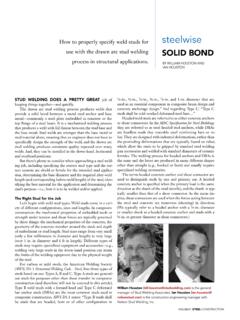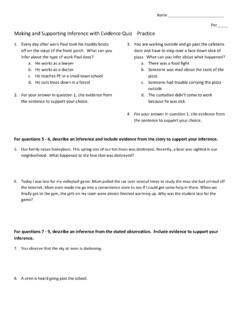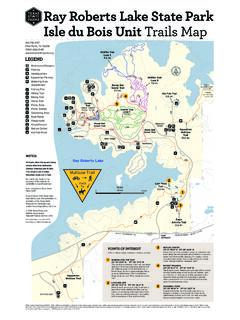Transcription of AP Chemistry Notes - akiscode.com
1 AP Chemistry NotesStephen AkikiColchester High SchoolDownload at Special Thanks to Stephen Bosley (Boser)Contents1 FOREWORD/DISCLAIMER42 Solubility Soluble .. Insoluble .. Naming Rules ..53 Periodic Table of Elements54 Poly Atomic Naming65 Common Units, Constants and Fundamental Constants .. Charge .. Radius ..76 Atomic Thompson .. Robert Millikan .. Ernest Rutherford .. Chadwick .. John Dalton ..77 Binary .. Prefixes .. Ionic .. Acids ..88 Cations99 Reaction Combination (Synthesis) .. Decomposition .. Binary Salt Splits .. Combustion ..1010 Blackbody Radiation1011 Bohr Energy Level Formula .. Energy Change during Level Jumps ..11112 De Broglie Formulas ..1113 Quantum Quantum Value Table .. Special cases ..1214 Electron Configuration .. Isoelectricity ..1315 Nuclear Isotopes .. Radiation .. Alpha Radiation.
2 Beta Radiation .. Gamma Radiation .. Positron Radiation .. Electron Capture .. Nuclear Equations .. Radiation Table .. Nuclear Stability .. Forces Invloved .. Belt of Stability .. Magic Numbers .. Half-Life ..1716 Ionization and Ionization Energy .. Electron Afinity ..1717 Reactions of Metals1718 Chemical Intramolecular .. Ionic Bonding .. Covalent Bonding .. Metallic Bonding .. Intermolecular .. Ion-Dipole .. Dipole-Dipole .. Hydrogen Bond .. London Dispersion/Van der Waals .. Intermolecular Flowchart .. Rule of Octet ..1919 Lewis Structures for Atoms .. Structures for Ions .. Structure for Ions of Molecules .. Lewis Structures for Molecular Structures (Covalent) .. Resonance Structures .. Formal Charge ..2120 Lattice Energies of Ionic Solids2121 Bond Lengths of Covalent Bonds2222 Dipole .. Dipole Moment ..22223 Bond Enthalpy2324 Bond Shape Table ..2325 Organic Polarity.
3 Alkanes .. Alkane Branch Structure Naming .. Branch Structure Naming Table .. Alkenes .. Alkene Naming .. Alkynes .. Alkyne Naming ..2726 Functional Alcohol .. Aldehyde .. Carboxylic Acid .. Ester .. Ketone .. Ether .. Amine .. Amide .. Haloalkane ..2927 Complex Cations .. Anions .. Coordination Number .. Naming .. Cations .. Anions ..3028 Acidic and Basic Acidic .. Basic ..3129 Enthalpy .. Stoichiometry Problems .. Calorimetry .. Hess Law .. Standard Heat of Formation .. Entropy .. State of Matter .. Number of Moles of Gasses .. Pressure of Gas .. Gibbs Law of Free Energy .. H, S, G, Relationship Table ..3430 Chemical Kinetics and Rate Physical State .. Concentration .. Temperature .. Pressure of Gas .. Catalysts and Inhibitors .. Rate Laws .. Order Table ..35331 Reaction Elementary Steps ..3732 Types of Equilibrium.
4 Equilibrium Constant Expressions .. Converting Constants ..3733 Gas Gas Units and Conversions .. Ideal Gas Law .. Real Gas Law .. Combined Gas Law .. Daltons Law of Partial Pressures .. Gas Collection over a Water Solution ..3934 ICE ICE (Baby)3935 Acids and Definitions of Acids and Bases .. pH and pOH .. Changing Concentrations .. Strong Acids and Bases .. Strong Acids .. Strong Bases .. Weak Acids and Bases .. Common Ion Effect .. Buffer ..4136 Equilibrium of Saturated, Soluable Salts4237 Kinetic Molecular Postulates: .. Root Mean Square Velocity .. Effusion and Diffusion .. Effusion .. Diffusion .. Finding the rate ..4338 Electro Identifying Oxidation Numbers .. Galvanic/Voltaic Cells .. Calculating Cell Potential .. Nernst Equation to FindE cell..4439 Balancing Redox Acidic .. Basic ..451 FOREWORD/DISCLAIMERF irst and formost, I am going to say what everone has on their really should not just forgetabout taking Notes anymore in AP Chemistry class because of this packet.
5 This packet is meant to be areviewand should be used as such. However that does not mean you can use this packet as your mainnotes and write Notes in the margins to supplement your take into account that this entirething was written over the course of 4 days. As such it is inevitable that I made mistakes in spelling you have any questions/comments/fixes to the text you can email me at Luck42 Solubility Soluble NitratesNO 13- All nitrates are soluble ChloratesClO 13- All chlorates are soluble Alkali metal Cations and Ammonium cation compoundsNH+14are all soluble Chlorides, Bromides, and Iodides are all soluble EXCEPTAg+1,Pb+2, andHg+2 Acetates - All are soluble exceptAg+ Sulfates - All are soluble exceptBa+2,Pb+2,Hg+2,Ca+2,Ag+1, andSr+ Insoluble CarbonatesCO 23- all carbonates are insoluble except alkali metals and ammonium compounds ChromatesCrO 24- all chromates are insoluble except alkali metals, ammonium,Ca+2, andSr+2 HydroxidesOH 1- all hydroxides are insoluble except alkali metals, ammonium,Ba+2,Sr+2, andCa+2although the last two (Sr+2andCa+2) are only slightly soluble so a precipitate can form.
6 PhosphatesPO 34all are insoluble except alkali metals and ammonium SulfitesSO 23all are insoluble except alkali metals and ammonium SulfidesS 2all are insoluble except Alkali metals, alkali earth metals and Naming Rules All strong acids and bases are soluble and should be written as the ions when completing net acid (H2SO4) should be written asH++HSO 14 The strong acids are:HCL,HBR,HI,HNO3,HClO4, andH2SO4 Strong bases are any alkali metal hydroxides (LiOH,NaOH, etc) andCa(OH)2,Sr(OH)2,Ba(OH)2 All acids and bases should be left in their molecular form:.Acetic acid HC2H3O23 Periodic Table of Elements54 Poly Atomic Naming ZincZn+2 SilverAg+1 AmmoniumNH+14 HydroxideOH 1 CyanideCN 1 NitrateNO 13 AcetateC2H3O 12 ChlorateClO 13 BromateBrO 13 IodateIO 13 ManganateMnO 13 SulfateSO 24 Bisulfate (Hydrogen Sulfate)HSO 14 CarbonateCO 23 Bicarbonate (Hydrogen Carbonate)HCO 13 SelenateSeO 24 Biselenate (Hydrogen Selenate)HSeO 14 OxalateC2O 24 PhosphatePO 34 Hydrogen PhosphateHPO 24 Dihydrogen PhosphateH2PO 14 ChromateCrO 24 PerAteAteIteHypoItePerIcIcOusHypoOus+1 OxygenMost Common Ion-1 Oxygen-2 Oxygen5 Common Units, Constants and Fundamental Constants Avogadros Number (N).
7 1023mol 1 Plancks Constant (h). 10 34J s Speed of Light (c). 108 Charge e charge = 10 19coulombs p+charge = 10 19coulombs Atomic Mass Unit (amu) = 10 24. p+= amu. n = amu. e = 10 RadiusAngstroms ( A) = 10 10meters6 Atomic Thompson Discoverede to Mass ratio: 108 Coulombs/Gram (Charge ofe /mass) Plum PuddingModel of Robert Millikan Found charge and mass ofe Millikan Oil Drop:.Charge oil drops in a field and adjust field until drops Ernest Rutherford Discovered 3 types of radiation (Decay Particles).Alpha particles:He2+size, very damaging, stoppable - .Beta particles -e size, damaging, hard to stop - .Gamma particles - tiny, not so damaging, unstoppable - Also discovered proton and newdense nucleus worked with particles most and discredited Thompsons model of the Chadwick Discovers neutron by shooting radiation at light elements and it watching it kick out a neutral John Dalton Four made of of one element differ from those of a different will combine in whole number can not be created or destroyed Law of Constant a compound, atom ratios are constant77 Binary Smallest atomic number comes first Second element ends with Greek Prefixes 1-Mono 2-Di 3-Tri 4-Tetra 5-Penta 6-Hexa 7-Hepta 8-Octa 9-Nona 10-DecaExampleCl2 ODichlorine Ionic Finding Charge:Na?
8 3Cl+12 NadcClab(a b)c= Polyatomic acid. HNO4 pernitric acid -ate ic acid. H+NO3 HNO3(Nitric Acid) -ite ous acid. HNO2 nitrous acid acid. HNO hyponitrous Binary Hydro + (stem)ic. H+Br Hydrobromic acid. H+N Hydronitric acid Acid HCO388 Cations Which cation forms a white precipate withHCL?. Ag+(reversed provesCl ). What color is a typical Manganese solution?.Pink/light purple. The precipate is dark black. How would you test forAl+and what would it look like?.Add Aluminom, it will make a precipate red and leave the solution clear. Which cation forms a gel like precipate?.Aluminum. Which cation turns deep red withKSCN?.Iron. How do you confirm the presence of zinc and what color is it?.Add acid, then ammonia, which results in a white/bluish precipate. What cation turns a deep blue with ammonia?. Reaction Combination (Synthesis)When two or more chemicals react to form one productExample2Mg+O2 2 MgO2Na+S Na2S Metal + Non-Metal Metal Nonmetal (Binary Salt) Metal Oxide + Water Metal Hydroxide.
9 CaO+H2O Ca(OH)2. K2O+H2O 2 KOH Metal Oxide +CO2 Metal Carbonate. Na2O+CO2 Na2CO3 Nonmetallic Oxides + water Acids (nonmetal oxides retains its oxide number). Na2O+SO3 DecompositionWhen one chemical decomposes into 2 or moreExample2Ag2O 4Ag+O2 = Heat Metal Carbonate Metal Oxide +CO2. CaCO3 CaO+CO2 Metal Hydroxide Metal Oxide +H2O. Mg(OH)2 MgO+H2O9 Metal Nonmetal Metal + Nonmetal (diatomic in nature).2 NaCl 2Na+Cl2 Metal Chlorates Metal Chlorides +O2. Fe(ClO3)2 FeCl3+ Special Binary Salt SplitsThese binary salts split into different elements(NH4)2CO3 NH3+H2O+CO2H2SO3 H2O+SO2H2CO3 H2O+CO2NH4OH NH3+H2OH2O2 H2O+ CombustionHydrocarbon+O2 CO2+ ..CxHy double x (multiply by 2) then add 2 C1: meth C2: eth C3: pro C4: bu C5: pent C6: hex C7: hept C8: oct C9: non C10: dec10 Blackbody RadiationWhen an object is heated it will emmit radiant energyE=h E = Energy h = Max Plancks constant ( 10 34J s) = frequencyPhotoelectric effect:Metal will give offe s if light shines on it.
10 Light shining on a clean sheet ofmetals will releasee s if is strong Bohr ModelNeils Bohr:1. Only orbits of certain radii, corresponding to certain definate energies are permitted for the electron ina hydrogen An electron in a permitted orbit has a specific energy and is in an allowed energy state. An electron inan allowed state will not radiate energy and therefore will not spiral into the Energy is emmitted or absorbed by thee only as thee changes from one allowed energy state theory because it only works for Energy Level FormulaEn= ( 10 18J)(1n2) E1: 10 18J E2: 10 19J E3: 10 19J E4: 10 19J E5: 10 20J E6: 10 20J E : Energy Change during Level Jumps E=EF E0 n = 3 2| 10 19J n = 4 2| 10 19J n = 5 2| 10 19J n = 6 2| 10 19J12 De Broglie Formulas =hmvor =hp = Wavelength h= Plancks Constant ( 10 34J s) m= Mass of particle inKg v= Velocity of particle (meterssecond) p= MomentumExamplem= 10 28gv= 106m/s = 10 34J s( 10 31Kg)( 106m/s)= 10 10m1113 Quantum Values1.






